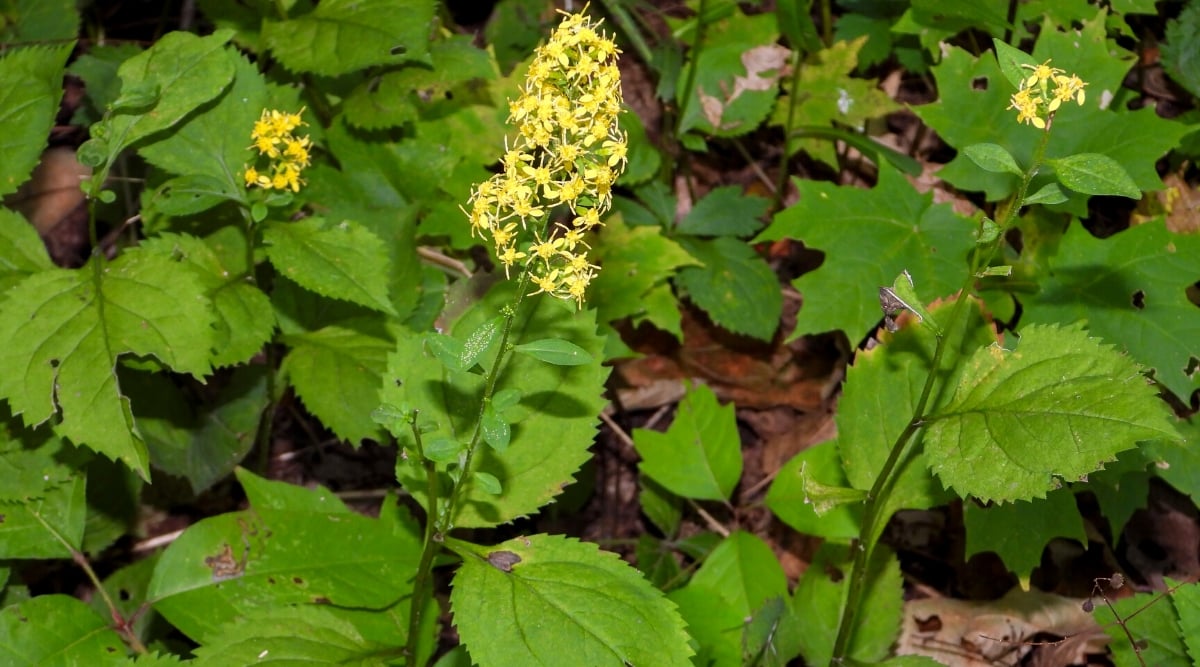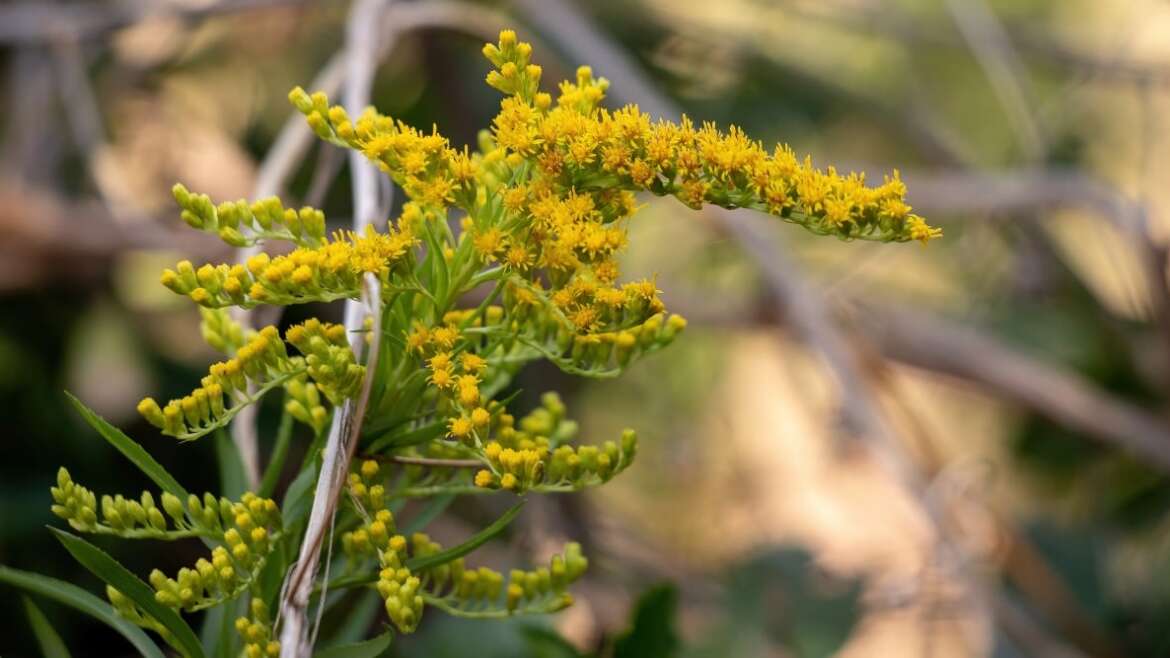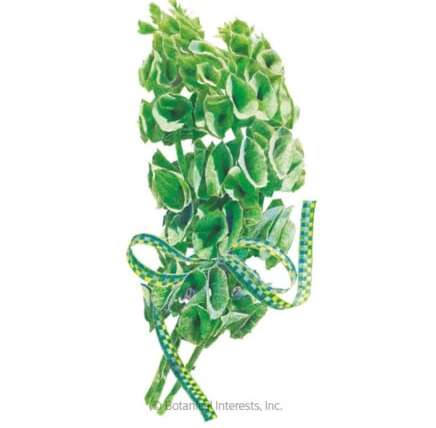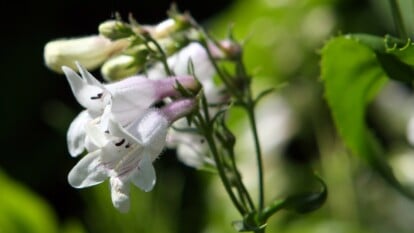Goldenrods are widespread perennial wildflowers in the aster family (Asteraceae). They are easy to grow, long-lasting, and beautiful! There are over 100 species of goldenrod and many showy cultivars that are popular with gardeners. Most species are native to North and South America, although there are some even found in Europe and Asia.
Goldenrods are diverse and well-adapted to many different environments. They grow naturally in the wild in open grasslands, fields, prairies, and along roadsides. Many like moist soils and grow around wetlands and low meadows. Some are tolerant of light to moderate shade and will grow in open woodlands, glades, and savannahs.
If you are looking for flowers to support butterflies, native bees, and other pollinators and beneficial insects, goldenrods are an ideal choice. Goldenrod flowers on a warm sunny day will be literally buzzing with activity. Grow these plants in a pollinator-friendly landscape, cottage garden, or native wildflower garden. They will also adapt very well to being grown in containers and raised beds.
If growing a goldenrod sounds appealing, keep reading to learn more about 11 different varieties of these beautiful flowers that you can grow in your own garden.
Anise-scented Goldenrod
The anise-scented goldenrod thrives in full sun and blooms late summer into fall.
The anise-scented goldenrod, also known as sweet goldenrod or fragrant goldenrod, is native to eastern North America. It grows best in full sun or partial shade but will develop denser, more compact vegetation in full sun. It prefers dry to medium-moisture, well-drained soil.
Anise-scented goldenrod is a clump-forming plant and does not spread aggressively. It stays relatively compact, reaching only one or two feet tall. Anise-scented goldenrod blooms from late summer into fall with plumes of pyramid-shaped flower clusters. The flowers are long-lasting, and the leaves have a pleasant fragrance.
Bluestem Goldenrod
 The bluestem goldenrod thrives in partially shaded landscapes, with arching stems and bright yellow flowers in late summer.
The bluestem goldenrod thrives in partially shaded landscapes, with arching stems and bright yellow flowers in late summer.
The bluestem goldenrod, also known as wreath goldenrod, is native to central and eastern North America. This goldenrod typically grows in open woodlands and would do well in a partially shaded landscape. Grow it in moist, well-drained soil.
Bluestem goldenrod is a clump-forming variety that does not spread aggressively. It can grow up to four feet tall but typically stays shorter than that, especially because the stems will grow in an arching habit. Small, loose clusters of bright yellow flowers bloom along the stems in late summer and early fall. As the name implies, the stems can have a blue or purplish coloration but do not always appear blue.
Canada Goldenrod
 This goldenrod can reach six feet tall in full sun and spreads rapidly in naturalized areas.
This goldenrod can reach six feet tall in full sun and spreads rapidly in naturalized areas.
Canada goldenrod is native throughout much of Canada and the United States, except for the extreme southeastern states. This variety spreads rapidly and would be best suited for a larger area rather than a small garden setting.
Canada goldenrod reaches a peak height of around six feet, making this a great plant for a tallgrass prairie landscape. The flowers bloom in late summer and may continue blooming until the first frost. The large yellow floral masses are densely packed in a pyramid-shaped cluster of finger-like projections.
Downy Goldenrod
 This goldenrod thrives in full sun, blooms from summer to fall, and attracts late-season pollinators.
This goldenrod thrives in full sun, blooms from summer to fall, and attracts late-season pollinators.
Downy goldenrod, also known as the downy ragged goldenrod, is native to the south-central and southeastern United States. This plant grows in full sun or partial shade and would be a good option for an open woodland garden. Give it moist soil.
‘Downy Goldenrod’ blooms from summer into fall. The flowers form in dense, bright yellow clusters atop a group of upright, leafy stems. This plant does well in warmer climates and is a good choice for southern states with high humidity. Are you looking for a great late-season pollinator magnet? Look no further than the downy goldenrod.
‘Fireworks’ Goldenrod
 This goldenrod cultivar, bursting with bright yellow flowers, thrives in full sun, making a stunning fall garden display.
This goldenrod cultivar, bursting with bright yellow flowers, thrives in full sun, making a stunning fall garden display.
‘Fireworks’ is a cultivar that produces lots of bright yellow flowers in dramatic finger-like bursts. ‘Fireworks’ reaches full bloom in the fall and adds some color and radiating form to your fall garden.
Grow ‘Fireworks’ in full sun for the best flower formation. This variety appreciates medium to moist soil and would be a good option for a rain garden or alongside a pond or other wetland. Allow these plants to spread into a dense cluster, and you will have your own golden fireworks display!
‘Goldkind’ Goldenrod
 This compact beauty offers showy, pollinator-friendly blooms from mid-summer to fall, perfect for cutting gardens.
This compact beauty offers showy, pollinator-friendly blooms from mid-summer to fall, perfect for cutting gardens.
‘Goldkind’ is a compact cultivar. These plants grow up to two feet tall and form attractive clumps. The flowers bloom from mid-summer until fall and put on a showy display. Dense, plume-like flower heads with many thin, branching tufts of tiny yellow flowers are sure to be a bee favorite. ‘Goldkind’ makes great flowers for cutting.
‘Goldkind’ grows best in full sun. Give it medium-moisture, well-drained soil. ‘Goldkind’ will spread by rhizomes but is not aggressive. Allow small clusters to grow and fill in for maximum showy appeal. This is a great addition to your cutting garden or cottage garden. Because of its smaller size, ‘Goldkind’ is easy to incorporate in many different garden styles.
‘Little Lemon’ Goldenrod
 This petite dwarf goldenrod adds charm with lemon-yellow blooms, perfect for smaller gardens or containers.
This petite dwarf goldenrod adds charm with lemon-yellow blooms, perfect for smaller gardens or containers.
‘Little Lemon’ is a goldenrod cultivar that is a petite dwarf variety. It grows to just 12 to 14 inches tall and makes an excellent addition to a smaller garden, container garden, or along edges and walkways. The showy lemon-yellow flowers bloom in late summer as a cluster of dense spikes atop each plant.
‘Little Lemon’ goldenrod likes full sun where it will grow into a neat clump. Give it medium moisture, well-drained soil. Don’t worry about this cultivar getting out of hand and taking over your garden. It will spread slowly. Cut back the flowers after the first bloom, and you might even get a second fall bloom.
Ohio Goldenrod
 This showy native perennial thrives in cooler climates with broad, flattened yellow blooms.
This showy native perennial thrives in cooler climates with broad, flattened yellow blooms.
Ohio goldenrod is a showy perennial wildflower native to the upper Midwestern states and Canada. It thrives in cooler climates and will do well in full sun or partial shade. It appreciates medium to moist soil.
The Ohio goldenrod is a fairly compact plant that grows between two and three feet tall. In the summer and fall, it blooms with dense, broad clusters of tiny yellow flowers. Many varieties have finger-like flower spikes. In comparison, the Ohio goldenrod has a much broader, flattened floral display.
Showy Goldenrod
 Native to central and eastern North America, Showy goldenrod thrives in cooler climates.
Native to central and eastern North America, Showy goldenrod thrives in cooler climates.
Showy goldenrod is native to much of central and eastern North America. It grows very well in cooler climates and appreciates full sun exposure. The soil should be dry to medium moisture with good drainage. This is a clump-forming perennial that can develop broad, attractive clusters.
Showy goldenrod blooms in late summer and into fall. It produces tall, dense clusters of tiny yellow flowers that form dramatic vertical spikes reaching high above the rest of the foliage. Plant these in a naturalized area or pocket prairie garden, and you will indeed have a very showy goldenrod specimen!
Zigzag Goldenrod
 This woodland perennial thrives in sun or partial shade, forming attractive clumps.
This woodland perennial thrives in sun or partial shade, forming attractive clumps.
The zigzag goldenrod, also known as the broadleaf goldenrod, is an herbaceous perennial native to the central and eastern United States and eastern Canada. This plant grows well in full sun or partial shade, but as a primarily woodland species, it is likely to perform best with at least some shade. It prefers medium-moisture, well-drained soil.
Zigzag goldenrod has broad leaves with densely ridged edges. The flowers bloom from mid-summer until early fall. There are a few small clumps of flowers along the upper parts of the leafy stems, with a loose spike of yellow flowers at the top. This is a clump-forming plant that will look best if allowed to develop into small clusters.
Frequently Asked Questions
Goldenrods are very diverse plants. They spread both by seed and by underground runners. There are indeed some varieties that will spread very quickly and have weedy tendencies, while others are much better behaved and tend to form clumps rather than try to take over your landscape. If you have a large naturalized area to fill, look for a goldenrod variety that spreads faster. If you want to keep your goldenrod contained in a smaller area, opt instead for a less aggressive variety.
Goldenrod is often mistakenly accused of causing allergies and hay fever. Goldenrods bloom late in the summer and into fall, at the same time as ragweed and other less conspicuous plants that do cause seasonal allergies due to their wind-blown pollen. Goldenrod pollen, on the other hand, is not wind-blown. Goldenrods are, in fact, insect-pollinated and make excellent flowers to attract valuable pollinators to your landscape.
Goldenrod plants are very easy to grow from seed. Seeds can be directly sown in the garden in the fall, winter, or early spring. Be aware, however, that if you want to grow any cultivars, you should start with a nursery-grown plant. Seeds from cultivars may not grow true to the parent plant. Any variety of goldenrod can also be easily propagated by the division of mature clumps. Don’t dig any native plants from the wild, but ask your gardening friends if they have any plants to share!
Final Thoughts
Goldenrods are often overlooked as garden plants, but they can add tremendous value to many diverse landscape settings. If you are growing plants for a pollinator garden, to attract bees and butterflies, to create a native wildflower landscape, or to produce cut flowers, try one of the many varieties of goldenrod. These plants are showy, easy to grow, and widely adaptable to different environmental conditions. Their cheery yellow flowers add some bright, late-season color to any landscape.




